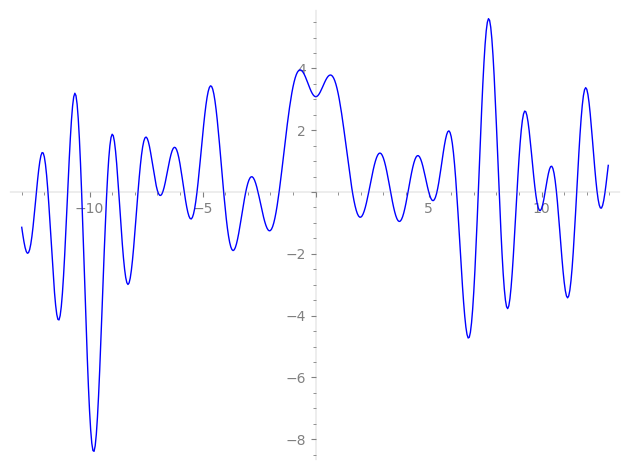| L(s) = 1 | + (0.923 + 0.382i)2-s + (0.608 − 0.793i)3-s + (0.707 + 0.707i)4-s + (0.866 + 0.5i)5-s + (0.866 − 0.499i)6-s + (0.382 + 0.923i)8-s + (−0.258 − 0.965i)9-s + (0.608 + 0.793i)10-s + (−0.258 − 0.448i)11-s + (0.991 − 0.130i)12-s + (−0.130 + 0.226i)13-s + (0.923 − 0.382i)15-s + i·16-s + (0.130 − 0.991i)18-s − i·19-s + (0.258 + 0.965i)20-s + ⋯ |
| L(s) = 1 | + (0.923 + 0.382i)2-s + (0.608 − 0.793i)3-s + (0.707 + 0.707i)4-s + (0.866 + 0.5i)5-s + (0.866 − 0.499i)6-s + (0.382 + 0.923i)8-s + (−0.258 − 0.965i)9-s + (0.608 + 0.793i)10-s + (−0.258 − 0.448i)11-s + (0.991 − 0.130i)12-s + (−0.130 + 0.226i)13-s + (0.923 − 0.382i)15-s + i·16-s + (0.130 − 0.991i)18-s − i·19-s + (0.258 + 0.965i)20-s + ⋯ |
\[\begin{aligned}\Lambda(s)=\mathstrut & 3420 ^{s/2} \, \Gamma_{\C}(s) \, L(s)\cr =\mathstrut & (0.984 - 0.173i)\, \overline{\Lambda}(1-s) \end{aligned}\]
\[\begin{aligned}\Lambda(s)=\mathstrut & 3420 ^{s/2} \, \Gamma_{\C}(s) \, L(s)\cr =\mathstrut & (0.984 - 0.173i)\, \overline{\Lambda}(1-s) \end{aligned}\]
Particular Values
| \(L(\frac{1}{2})\) |
\(\approx\) |
\(3.084493288\) |
| \(L(\frac12)\) |
\(\approx\) |
\(3.084493288\) |
| \(L(1)\) |
|
not available |
| \(L(1)\) |
|
not available |
\(L(s) = \displaystyle \prod_{p} F_p(p^{-s})^{-1} \)
| $p$ | $F_p(T)$ |
|---|
| bad | 2 | \( 1 + (-0.923 - 0.382i)T \) |
| 3 | \( 1 + (-0.608 + 0.793i)T \) |
| 5 | \( 1 + (-0.866 - 0.5i)T \) |
| 19 | \( 1 + iT \) |
| good | 7 | \( 1 + (-0.5 + 0.866i)T^{2} \) |
| 11 | \( 1 + (0.258 + 0.448i)T + (-0.5 + 0.866i)T^{2} \) |
| 13 | \( 1 + (0.130 - 0.226i)T + (-0.5 - 0.866i)T^{2} \) |
| 17 | \( 1 + T^{2} \) |
| 23 | \( 1 + (0.5 + 0.866i)T^{2} \) |
| 29 | \( 1 + (-0.5 + 0.866i)T^{2} \) |
| 31 | \( 1 + (-0.5 - 0.866i)T^{2} \) |
| 37 | \( 1 + 1.98T + T^{2} \) |
| 41 | \( 1 + (-0.5 - 0.866i)T^{2} \) |
| 43 | \( 1 + (-0.5 + 0.866i)T^{2} \) |
| 47 | \( 1 + (0.5 - 0.866i)T^{2} \) |
| 53 | \( 1 - 1.58iT - T^{2} \) |
| 59 | \( 1 + (0.5 + 0.866i)T^{2} \) |
| 61 | \( 1 + (-0.707 - 1.22i)T + (-0.5 + 0.866i)T^{2} \) |
| 67 | \( 1 + (0.662 + 0.382i)T + (0.5 + 0.866i)T^{2} \) |
| 71 | \( 1 - T^{2} \) |
| 73 | \( 1 - T^{2} \) |
| 79 | \( 1 + (-0.5 + 0.866i)T^{2} \) |
| 83 | \( 1 + (0.5 - 0.866i)T^{2} \) |
| 89 | \( 1 + T^{2} \) |
| 97 | \( 1 + (-0.382 - 0.662i)T + (-0.5 + 0.866i)T^{2} \) |
| show more | |
| show less | |
\(L(s) = \displaystyle\prod_p \ \prod_{j=1}^{2} (1 - \alpha_{j,p}\, p^{-s})^{-1}\)
Imaginary part of the first few zeros on the critical line
−8.708390003868704891477011715844, −7.85571150202940693707178324385, −6.97688547084676698181361246107, −6.76047016089703237441177339685, −5.80946796369861862267061480714, −5.24568500925519415189535144823, −4.06669828816193823211183202320, −3.08883211138474393056184093888, −2.54651344141583480817314172418, −1.61303719224610127778219672985,
1.63089219567253829554908073721, 2.35277429052595117541343226122, 3.32082762612467096179110676129, 4.09112264030363150515267008243, 5.00770864261378452156068816641, 5.36951074022166469050599111935, 6.24137218019753644654124554110, 7.20022717990343566518624490483, 8.124008051369181290870806941067, 8.911010818250273608501310483662

